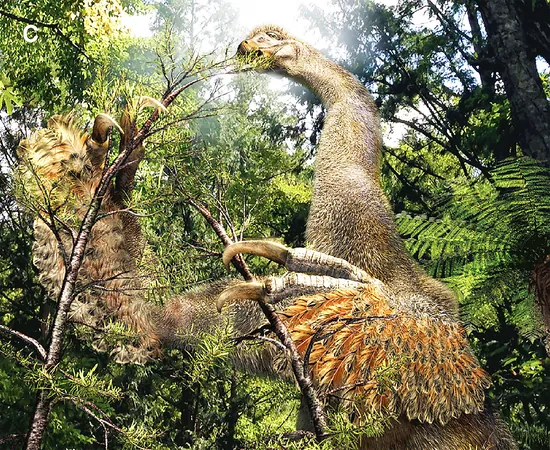
Unveiling Duonychus tsogtbaatari: The Two-Clawed Dinosaur Redefining Prehistoric Curiosities
2025-04-03
Author: Yan
The Discovery: Science Meets the Unusual
Recently unearthed by a collaborative team from the University of Calgary and Mongolia's Institute of Paleontology, Duonychus tsogtbaatari—Greek for "two claws"—has garnered attention not simply for its size but for the incredible preservation of its keratin claw sheath, a remarkable rarity in dinosaur fossils. According to research lead Darla Zelenitsky, a paleontologist at the University of Calgary, “It’s close to a foot (30 cm) in size, which is by far the largest preserved claw with keratin sheath for any known dinosaur.”
Not Your Average Carnivore
Part of the therizinosaur group, Duonychus tsogtbaatari stands out due to its strictly herbivorous diet, a stark contrast to its more famous theropod relatives like Tyrannosaurus rex, which were predominantly meat-eaters. Therizinosaurs, including Duonychus, evolved unique adaptations such as beak-like mouths and specialized teeth for processing plant material. Their monumental claws, which could reach over a meter in some species, were likely employed for defense and foraging.
Interestingly, fossils of therizinosaurs—including the well-known Therizinosaurus—have drawn attention for revealing a lineage closely aligned with feathered dinosaurs and modern birds. Findings suggest that Duonychus tsogtbaatari may have been feathered, possibly for insulation or mating displays, much like its avian descendants.
A Glimpse Into Cretaceous Life
The fossil remains of Duonychus include not only its impressive claws but also portions of the spine, tail, hips, arms, and legs, providing paleontologists a more comprehensive understanding of its structure and lifestyle. Estimates suggest that Duonychus stood about 10 feet (3 meters) tall and weighed around 573 pounds (260 kilograms). With just two massive digits, its hands seem uniquely designed for reaching out to grasp tree branches and pull down vegetation—an evolutionary marvel.
Zelenitsky compared Duonychus's claws to those of modern sloths, which utilize their curved nails to navigate through trees. However, the additional size and shape of Duonychus's claws lend a prehistoric twist to its feeding strategy. While scientists believe that these claws were mainly for grabbing plants, they also held potential for self-defense against predators—an essential trait in a world dominated by larger, meat-eating dinosaurs.
A Unique Place in the Dinosaur Kingdom
Furthermore, the two-fingered limb structure of Duonychus is a rare trait among dinosaurs. While the infamous T. rex also exhibited two digits, his limited limb functionality was a stark contrast to the agile feeding strategy of Duonychus. “While T. rex probably wasn’t using its pathetic little arms for much, these therizinosaurs employed theirs in a fundamental way for feeding,” pointed out Steve Brusatte, a professor at the University of Edinburgh.
The extraordinary fossil was recovered from the lower Upper Cretaceous Bayanshiree Formation. This beautiful slice of prehistoric Earth not only unveils a creature unlike any other but serves as a vital link in understanding the diversity and evolution of dinosaurs.
Conclusion: A Window into the Weird and Wonderful Past
Duonychus tsogtbaatari, with its sloth-like claws and possibly feathered appearance, makes for a compelling reminder of the bizarre adaptations that once roamed our planet. As we continue to dig through layers of history, this newfound dinosaur underscores the reality that the past is often stranger and more fascinating than we can imagine. The groundbreaking study revealing these findings was published in the journal iScience, heralding an exciting era for paleontological research.




 Brasil (PT)
Brasil (PT)
 Canada (EN)
Canada (EN)
 Chile (ES)
Chile (ES)
 Česko (CS)
Česko (CS)
 대한민국 (KO)
대한민국 (KO)
 España (ES)
España (ES)
 France (FR)
France (FR)
 Hong Kong (EN)
Hong Kong (EN)
 Italia (IT)
Italia (IT)
 日本 (JA)
日本 (JA)
 Magyarország (HU)
Magyarország (HU)
 Norge (NO)
Norge (NO)
 Polska (PL)
Polska (PL)
 Schweiz (DE)
Schweiz (DE)
 Singapore (EN)
Singapore (EN)
 Sverige (SV)
Sverige (SV)
 Suomi (FI)
Suomi (FI)
 Türkiye (TR)
Türkiye (TR)
 الإمارات العربية المتحدة (AR)
الإمارات العربية المتحدة (AR)